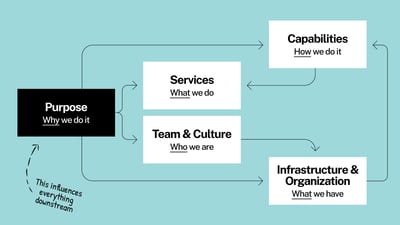Why a One-Page Plan Belongs in Your Strategic Planning Process

All nonprofit executives recognize corporate strategy development is important. But it’s a safe assumption that most also find the creation of their organization’s strategic plan to be daunting, sometimes scary. When making decisions on the path ahead, you will cut off other possibilities and opportunities. Those choices become a reflection of you as a leader and what if they don’t pan out?
When operating with that fear, nonprofit leaders tend to turn to the past and traditional strategic planning methodology to justify their decisions. This can look like too many priorities, months of collaboration, benchmark research and citations, spreadsheets and cost projections, and pages upon pages of strategic planning documentation to validate “this is the right call.” If the goal is to make everyone feel safe, then this works. But if the goal is to build an effective, business strategy formulation, this is not a valuable use of time or donor dollars.
If you’re comfortable during organizational strategic planning, chances are, you’re doing it wrong.
You’re stifling growth, innovation, and creativity when you let fear or comfort drive.
You can streamline the creation of a meaningful strategic plan without losing substance. A few rules to remember when embarking on this strategic planning process:
- Keep your strategic planning approach simple - ruthless prioritization, clarity, and brevity are required for shared understanding.
- Recognize perfection is not possible - your plan will not remain fixed. It’s a place to deviate from when the circumstances change (because they will!).
- Be explicit with your logic - articulate (and document) the reasons behind your decisions, so fellow leaders can understand if the desired outcomes are being produced once the plan is in motion.
Out of hundreds of nonprofit clients I’ve partnered with, I can only remember one leader expressing they had the luxury of time to ponder, conduct market research, and consult with several of their trusted peers in the sector. They happened to be a retired board chair of an organization raising more than $100MM in annual revenue. For most nonprofit leaders, you need results. And fast.
That’s where a one-page strategic plan comes in. It’s a 30,000-foot view of your priorities, objectives, and direction. It quite literally gets everyone on the same page. It’s deceptively simple, but it forces you to get to the heart of what you’re trying to achieve.
Start by defining the two most critical components of your strategy - your purpose and guiding policies.
Purpose - Why do we exist? What purpose do we serve? This is not your probably-too-wordy mission statement. Define a practical purpose that is unlikely to dramatically change when you review it in a year or two. Here’s an example in practice:
- We exist to land a man on the moon and return him safely back to Earth.
- We do this for the entire American nation and the free world.
- We do this by going all in: if we go only half way, we should not go at all.
Guiding policies - How do we realize our purpose? Think about what’s possible for you in the next 1-3 years. Your policies need to be instilled with the same DNA as the purpose. Let’s keep the moon landing example going:
- We realize this by removing bureaucratic obstacles and inter-agency competition.
- We realize this by developing the means that get us there: space craft, fuels, training astronauts.
- We realize this by committing science, manpower, and material to this goal–even if we have to remove them from other important activities.
In absence of step-by-step instruction documented across dozens or hundreds of pages, your purpose and guiding policies will empower teammates at all levels of your organization to use them as an ever present filter when making decisions (what you hired them for!). Brevity gets the crown when it comes to communicating an overarching strategy to teammates at all levels.
There’s a place for complex, in-depth documentation and research, but not when it comes to your strategic planning routine. You may need to practice sitting with the tension of your decisions, but recognize if you’ve got a plan built upon strengths and necessary context from your peers, you’re on the right track.
After you’ve defined your purpose and guiding policies, use a structured discussion to surface and solve for the greatest challenges your organization might face in realizing its purpose. Check out our Problem-Solving Framework, an inclusive exercise to help you and your team get to “yes.”
There are a few more components that should be featured on your one-page strategic plan, like your primary strategic plans for growth, high-impact campaigns throughout the year, and key content themes that will resonate most with your audience(s) and align with your purpose. We’ll cover these in future articles, but today’s key takeaway is that a one-page strategic plan will take your team further faster.
Subscribe to the Switchboard, CauseMic’s newsletter for more insights on effective strategic planning. On average, we deliver a couple emails each month - always crafted with the purpose of helping social impact leaders quickly grow their organization.





